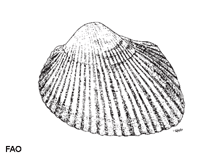Scapharca cornea (Reeve, 1844)
Corneous ark| Native range | All suitable habitat | Point map | Year 2050 |

|
| This map was computer-generated and has not yet been reviewed. |
| Scapharca cornea AquaMaps Data sources: GBIF OBIS |
Classification / Names Common names | Synonyms | CoL | ITIS | WoRMS
Bivalvia | Arcida | Arcidae
Environment: milieu / climate zone / depth range / distribution range Ecology
Benthic; depth range 0 - 20 m. Tropical, preferred 18°C (Ref. 107945)
Distribution Countries | FAO areas | Ecosystems | Occurrences | Introductions
Western Pacific. Introduced in the Black Sea.
Length at first maturity / Size / Weight / Age
Maturity: Lm ? range ? - ? cm Max length : 6.0 cm TL male/unsexed; (Ref. 348); common length : 4.0 cm TL male/unsexed; (Ref. 348)
Short description Morphology
Life cycle and mating behavior Maturity | Reproduction | Spawning | Eggs | Fecundity | Larvae
Main reference
References | Coordinator | Collaborators
Poutiers, J.M. 1998. (Ref. 348)
IUCN Red List Status
(Ref. 130435: Version 2024-2)
CITES status (Ref. 108899)
CMS (Ref. 116361)
Threat to humans
Human uses
Fisheries: commercial
FAO - Fisheries: landings | FishSource | Sea Around Us
Tools
More information
Diet composition
Food consumption
Predators
Max. ages / sizes
Length-weight rel.
Length-length rel.
Length-frequencies
Mass conversion
Abundance
Internet sources
BHL | BOLD Systems | CISTI | DiscoverLife | FAO(Fisheries: ; publication : search) | Fishipedia | GenBank (genome, nucleotide) | GloBI | Gomexsi | Google Books | Google Scholar | Google | PubMed | Tree of Life | Wikipedia (Go, Search) | Zoological Record



